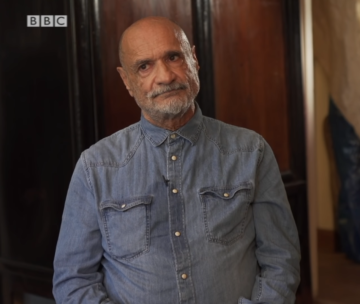Sophia Chen in Nature:
 Many industries are betting that they will benefit from the anticipated quantum-computing revolution. Pharmaceutical companies and electric-vehicle manufacturers have begun to explore the use of quantum computers in chemistry simulations for drug discovery or battery development. Compared with state-of-the-art supercomputers, quantum computers are thought to more efficiently and accurately simulate molecules, which are inherently quantum mechanical in nature.
Many industries are betting that they will benefit from the anticipated quantum-computing revolution. Pharmaceutical companies and electric-vehicle manufacturers have begun to explore the use of quantum computers in chemistry simulations for drug discovery or battery development. Compared with state-of-the-art supercomputers, quantum computers are thought to more efficiently and accurately simulate molecules, which are inherently quantum mechanical in nature.
From software developers to biologists and chemists, users are now investigating whether quantum technology can bolster their fields. But there is still lively debate about how the technology will pan out, says physicist Olivia Lanes, a researcher at IBM in Yorktown Heights, New York. “A lot of people don’t want to enter the industry until they see the technology is robust, but can we make it robust without them?”
More here.

 As news of Hamas’s murderous October 7 surprise attack on Israel started to circulate in the global information space, so too did the propaganda. According to one estimate, the Israel-Hamas war sparked the highest volume of global propaganda—emanating not just from Israel, Palestine and other Middle Eastern countries but also from Russia, China, and Iran—that experts had ever seen. Even more so than after Russia’s full-scale invasion of Ukraine in late February 2022, the outbreak of war between Israel and Hamas was springtime for propaganda.
As news of Hamas’s murderous October 7 surprise attack on Israel started to circulate in the global information space, so too did the propaganda. According to one estimate, the Israel-Hamas war sparked the highest volume of global propaganda—emanating not just from Israel, Palestine and other Middle Eastern countries but also from Russia, China, and Iran—that experts had ever seen. Even more so than after Russia’s full-scale invasion of Ukraine in late February 2022, the outbreak of war between Israel and Hamas was springtime for propaganda. More shadows than men, really; just silhouettes, might as well be smudges on the lens. Hard to notice at first, the two undifferentiated figures in the lower left-hand of the picture, at the corner of the Boulevard du Temple. A bootblack squats down and shines the shoes of a man contrapasso above him; impossible to tell what they’re wearing or what they look like. Obviously no way to ascertain their names or professions. At first they’re hard to recognize as people, these whispers of a figure joined together, eternally preserved by silver-plated copper and mercury vapor; they’re insignificant next to the buildings, elegant Beaux-Arts shops and theaters, wrought iron railings along the streets and chimneys on their mansard roofs. Based on an analysis of the light, Louis Daguerre set up his camera around eight in the morning; leaves are still on trees, so it’s not winter, but otherwise it’s hard to tell what season it is that Paris day in 1838. Whatever their names, it was by accident that they became the first two humans to be photographed.
More shadows than men, really; just silhouettes, might as well be smudges on the lens. Hard to notice at first, the two undifferentiated figures in the lower left-hand of the picture, at the corner of the Boulevard du Temple. A bootblack squats down and shines the shoes of a man contrapasso above him; impossible to tell what they’re wearing or what they look like. Obviously no way to ascertain their names or professions. At first they’re hard to recognize as people, these whispers of a figure joined together, eternally preserved by silver-plated copper and mercury vapor; they’re insignificant next to the buildings, elegant Beaux-Arts shops and theaters, wrought iron railings along the streets and chimneys on their mansard roofs. Based on an analysis of the light, Louis Daguerre set up his camera around eight in the morning; leaves are still on trees, so it’s not winter, but otherwise it’s hard to tell what season it is that Paris day in 1838. Whatever their names, it was by accident that they became the first two humans to be photographed. The rhythm of life is hardwired into our DNA. More than forty percent of the human genes that code for proteins
The rhythm of life is hardwired into our DNA. More than forty percent of the human genes that code for proteins  Branagh’s Poirot films occupy an increasingly strange place in the increasingly weird ecosystem: the twenty-first century metroplex. Murder on the Orient Express (2017) entered an economy still starry on the possibilities of IP-mining, as top-grossing films of that year exclusively feature Disney properties and pop culture products as heroes. Death on the Nile (2022) appeared to an industry in the throes of its latest crisis, ravaged both by pandemic-induced closures and delays as well as the burgeoning sense that the terrain of our memories handled at the hands of slick corporate storytelling might not be a sustainable model of cultural dispensation. Indeed, several of the top-grossing films of 2022 feature the same trademarks from five years prior (Batman, Thor, the Minions) while folding in “new” revisitations (Avatar, Top Gun, Puss in Boots). Nile’s release, like so many films shot in the wilderness of late 2019 and early 2020, was pushed and pulled like taffy, a cultural object in search of distribution in an industry increasingly at the mercy of corporate conglomeration, content optimization, and a boring spring towards the moral and artistic middle.
Branagh’s Poirot films occupy an increasingly strange place in the increasingly weird ecosystem: the twenty-first century metroplex. Murder on the Orient Express (2017) entered an economy still starry on the possibilities of IP-mining, as top-grossing films of that year exclusively feature Disney properties and pop culture products as heroes. Death on the Nile (2022) appeared to an industry in the throes of its latest crisis, ravaged both by pandemic-induced closures and delays as well as the burgeoning sense that the terrain of our memories handled at the hands of slick corporate storytelling might not be a sustainable model of cultural dispensation. Indeed, several of the top-grossing films of 2022 feature the same trademarks from five years prior (Batman, Thor, the Minions) while folding in “new” revisitations (Avatar, Top Gun, Puss in Boots). Nile’s release, like so many films shot in the wilderness of late 2019 and early 2020, was pushed and pulled like taffy, a cultural object in search of distribution in an industry increasingly at the mercy of corporate conglomeration, content optimization, and a boring spring towards the moral and artistic middle. Modern biomedicine has, of course, delivered breakthrough treatments over the past century, treatments which have transformed the care of diseases which were once considered incurable. Aspirin for heart attacks. Insulin for diabetes. Potent antibiotics to treat infections caused by highly virulent organisms. These interventions are true marvels of the modern age: they’re safe and effective for conditions that affect millions. We should rightfully celebrate such treatments and work to make them widely and freely available.
Modern biomedicine has, of course, delivered breakthrough treatments over the past century, treatments which have transformed the care of diseases which were once considered incurable. Aspirin for heart attacks. Insulin for diabetes. Potent antibiotics to treat infections caused by highly virulent organisms. These interventions are true marvels of the modern age: they’re safe and effective for conditions that affect millions. We should rightfully celebrate such treatments and work to make them widely and freely available. Cleaning, like cooking, childbearing, and breastfeeding, is a paradigm case of reproductive labor. Reproductive labor is a special form of work. It doesn’t itself produce commodities (coffee pots, silicon chips); rather, it’s the form of work that creates and maintains labor power itself, and hence makes the production of commodities possible in the first place. Reproductive labor is low-prestige and (typically) either poorly paid or entirely unwaged. It’s also obstinately feminized: both within the social imaginary and in actual fact, most reproductive labor is done by women. It is perhaps unsurprising, then, that political discussions of work often treat reproductive labor as an afterthought.
Cleaning, like cooking, childbearing, and breastfeeding, is a paradigm case of reproductive labor. Reproductive labor is a special form of work. It doesn’t itself produce commodities (coffee pots, silicon chips); rather, it’s the form of work that creates and maintains labor power itself, and hence makes the production of commodities possible in the first place. Reproductive labor is low-prestige and (typically) either poorly paid or entirely unwaged. It’s also obstinately feminized: both within the social imaginary and in actual fact, most reproductive labor is done by women. It is perhaps unsurprising, then, that political discussions of work often treat reproductive labor as an afterthought. T
T Another Thanksgiving, another case study in the complex relationship between gratitude and discontent in America. In many respects, a typical U.S. family’s cup runneth over, especially relative to the situations facing families in places such as Ukraine, Gaza, Israel, Venezuela, Afghanistan — the list of poor, oppressed or war-torn nations is long. Macroeconomic data indicates that unemployment is hovering near all-time lows, that inflation is coming down, possibly without a recession, and that
Another Thanksgiving, another case study in the complex relationship between gratitude and discontent in America. In many respects, a typical U.S. family’s cup runneth over, especially relative to the situations facing families in places such as Ukraine, Gaza, Israel, Venezuela, Afghanistan — the list of poor, oppressed or war-torn nations is long. Macroeconomic data indicates that unemployment is hovering near all-time lows, that inflation is coming down, possibly without a recession, and that  When describing her directing philosophy, Barbra Streisand has said that less is often more. Unfortunately, she did not take that to heart when writing her long-awaited memoir, My Name is Barbra, which clocks in at over 900 pages.
When describing her directing philosophy, Barbra Streisand has said that less is often more. Unfortunately, she did not take that to heart when writing her long-awaited memoir, My Name is Barbra, which clocks in at over 900 pages. AGI is
AGI is  More than at any other time since World War II, liberalism is under siege. On the left, some people insist that liberalism is exhausted and dying and unable to handle the problems posed by entrenched inequalities, corporate power and environmental degradation. On the right, some people think that liberalism is responsible for the collapse of traditional values, rampant criminality, disrespect for authority and widespread immorality.
More than at any other time since World War II, liberalism is under siege. On the left, some people insist that liberalism is exhausted and dying and unable to handle the problems posed by entrenched inequalities, corporate power and environmental degradation. On the right, some people think that liberalism is responsible for the collapse of traditional values, rampant criminality, disrespect for authority and widespread immorality. Ave had started making photocollages of wrestlers in the late ’90s, titling them after characters from the epic tenth-century Iranian poem the Shahnameh (Book of Kings). His main protagonist was Rostam, a warrior of legendary strength and wisdom whom Ave reanimated in images of the young Iranian wrestling champion Abbas Jadidi. In 1996, Jadidi had nearly claimed Olympic gold in Atlanta in an epic match settled by what appeared to be the whims of the American judges—a bit of geopolitical theater, perhaps, at a time when the US was dramatically ramping up sanctions against Iran. Jadidi brought home the silver and went on to win other championships (and enter local politics), but the loss of the gold was deeply felt in a country where wrestling traces its roots to pre-Islamic rites.
Ave had started making photocollages of wrestlers in the late ’90s, titling them after characters from the epic tenth-century Iranian poem the Shahnameh (Book of Kings). His main protagonist was Rostam, a warrior of legendary strength and wisdom whom Ave reanimated in images of the young Iranian wrestling champion Abbas Jadidi. In 1996, Jadidi had nearly claimed Olympic gold in Atlanta in an epic match settled by what appeared to be the whims of the American judges—a bit of geopolitical theater, perhaps, at a time when the US was dramatically ramping up sanctions against Iran. Jadidi brought home the silver and went on to win other championships (and enter local politics), but the loss of the gold was deeply felt in a country where wrestling traces its roots to pre-Islamic rites. EVERYONE FINDS
EVERYONE FINDS